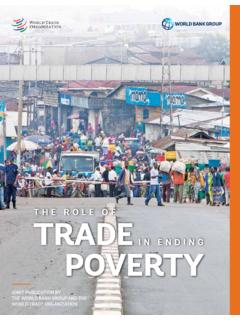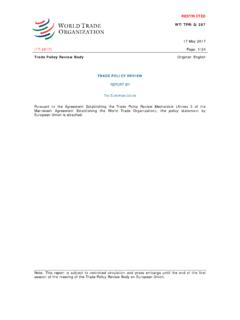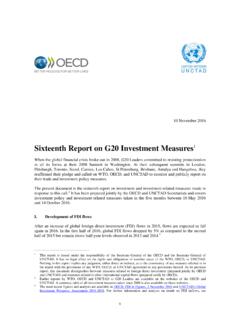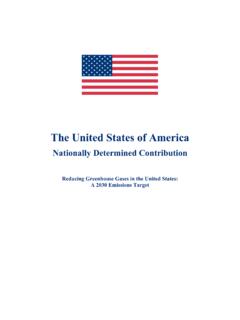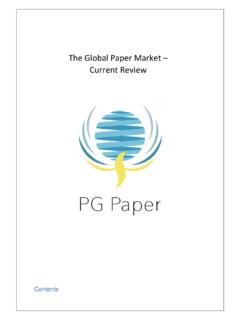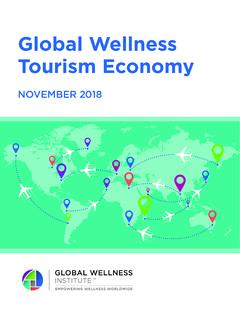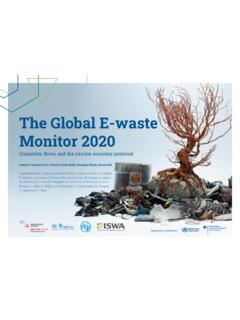Transcription of Trade in Value Added and Global Value Chains
1 WTO " Trade in Value - Added and Global Value Chains " profiles Explanatory notes The WTO " Trade in Value - Added and Global Value Chains " statistical profiles give an overview of the key indicators that can be derived from Trade in Value - Added statistics. The profiles are broken down into four sections providing insights on: The Value Added contribution of foreign Trade to an economy ; The interconnection of national economies within Global Value Chains (GVCs); The impact of the services industry on Trade ; The level of Trade in merchandise and services intermediate products. The indicators shown in the first three sections of the profiles rely on the online OECD Trade in Value - Added database (TiVA) stemming from a joint OECD-WTO TiVA initiative.
2 The TiVA online database can be accessed from or via TiVA indicators cover goods and services and are available for a set of 64 economies and 36 industries from the International Standard Industrial Classification, (ISIC Revision 4). Hence, t he number of profiles available as well as the main partners and industries shown in the tables reflect the current coverage of the TiVA database. The annexes present the lists of economies and industries available in TiVA as well as the definitions of economy and industry groups used in the profiles. As per convention, the symbol ".." is applied whenever data are "not available or not reported".
3 About data differences between the 2018 and 2016 versions of TiVA indicators The 2018 version of the TiVA database, on which these " Trade in Value - Added and Global Value Chains " profiles rely, brings some notable differences in the level of some GVC-related indicators. This is mainly due to the following changes in the data underlying TiVA indicators: - Implementation of a new version of the System of National Accounts (SNA 2008 vs SNA 1993 in previous profiles) that impacted on the treatment of research and development, processing Trade and merchanting activities. - Adoption of the 4th Revision of the ISIC classification, leading to compositional effects in the revised set of industries applied in TiVA.
4 - Changes in official statistics, through revisions and access to new data sources, have contributed to improve data quality and may have had an impact on TiVA indicators. For more details, please consult the following OECD note: The " Trade in Value - Added and Global Value Chains " profiles are divided into the following sections: SECTION 1: Value Added CONTENT OF GROSS EXPORTS The estimation of Trade in Value Added terms shows the decomposition of gross exports into their domestic and foreign Value - Added contents. The domestic Value - Added content of exports is composed of the following three elements: Domestic Value Added sent to consumer economy corresponds to the domestic Value Added embodied either in final or intermediate goods or services that is directly consumed by the importing economy .
5 Domestic Value Added sent to third economies represents the domestic Value Added contained in intermediates (goods or services) exported to a partner economy that re-exports them to a third economy as embodied in other products. This illustrates the multiple Value - Added exchanges taking place among GVCs an d corresponds to the "Forward GVC participation" shown in the next section. Domestic Value Added re-imported in the economy refers to the domestic Value Added of exported intermediates, or inputs, that is sent back to the economy of origin as embodied in other intermediates and used to produce exports.
6 Such a Value Added round-trip between two (or more) economies highlights the domestic Value Added content present in an economy 's imports. Foreign Value - Added content of exports corresponds to the Value Added of inputs that were imported in order to produce intermediate or final goods/services to be exported. It corresponds to the "Backward GVC participation" shown in the next section. It is also referred to as "Vertical specialization" when expressed as a percentage of gross exports. Source: OECD TiVA Database. To further illustrate the terms described above, Figure 1 shows the production and Trade flows corresponding to the Value Added components of exports.
7 Figure 1. The Value Added components of gross exports and GVC Trade flows SECTION 2: PARTICIPATION IN Global Value Chains (GVCs) The GVC participation index provides an estimation of how much an economy is connected to Global Value Chains for its foreign Trade . The indicator is composed of two components reflecting the upstream and downstream links in international production Chains . Basically, individual economies participate in Global Value Chains by importing foreign inputs to produce the goods and services they export (backward GVC participation) and also by exporting domestically produced inputs to partners in charge of downstream production stages (forward GVC participation).
8 See Figure 1. Backward GVC participation refers to the ratio of the "Foreign Value Added content of exports" (see definition in Section 1) to the economy 's total gross exports. This is the "Buyer" perspective or sourcing side in GVCs, where an economy imports intermediates to produce its exports. Forward GVC participation corresponds to the ratio of the "Domestic Value Added sent to third economies" (see Section 1) to the economy 's total gross exports. It captures the domestic Value Added contained in inputs sent to third economies for further processing and export through Value Chains . This is the "Seller" perspective or supply side in GVC participation.
9 Source: OECD TiVA Database. SECTION 3: ROLE OF SERVICES Value Added IN EXPORTS The compilation of Trade in Value Added terms also allows for the estimation of the actual contribution of services in the exports of an economy , in a way that is more accurate than with traditional statistical methods. This section provides insights on the contribution of services in exports of manufactures, where firms combine goods and services into product packages, as well as in total exports. The "Top services industries' contributions to exports" figures include both domestic and foreign origins. Source: OECD TiVA Database. SECTION 4: Trade IN INTERMEDIATE PRODUCTS Intermediate goods and services are tangible and intangible products utilized as inputs in production, excluding fixed assets.
10 Trade statistics on intermediate products reflect the exchanges of parts, components, accessories and intermediary services taking place within international production Chains . Merchandise exports/imports in intermediates The definition of intermediate goods relies upon the United Nations' Broad Economic Categories (BEC) classification, which groups commodities by main end-use, distinguishing between consumption, capital and intermediate goods. The following (sub-)categories are included: 111: primary food and beverages, mainly for industry 121: processed food and beverages, mainly for industry 2: Industrial supplies not elsewhere specified 42: parts and accessories for capital goods 53: parts and accessories for transport equipment Oil is excluded from the calculations.
